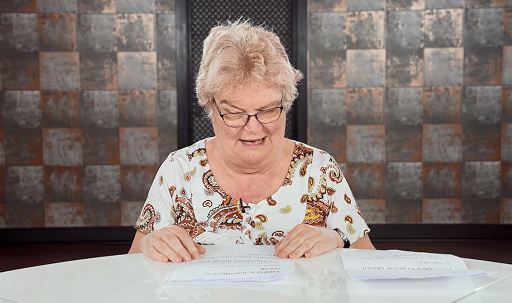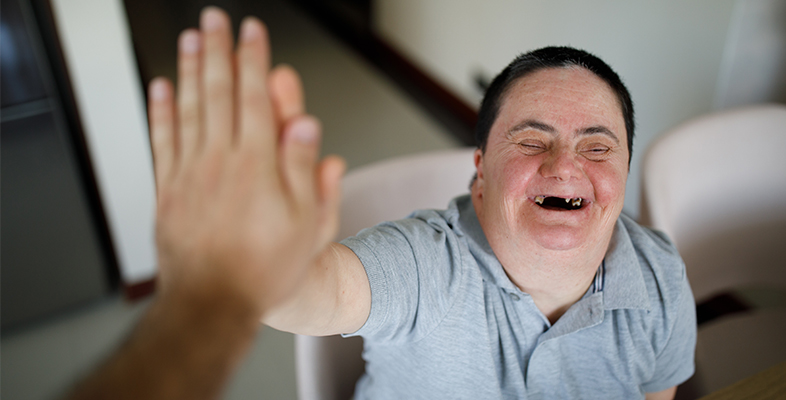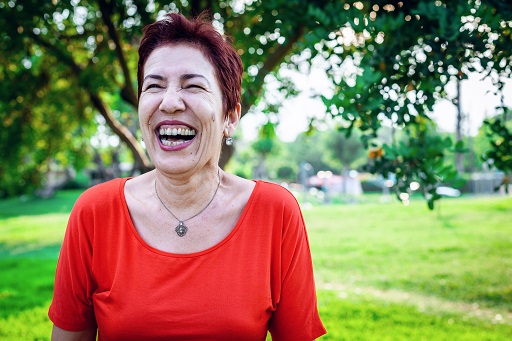1 Introducing Susie
You’ll now learn about Susie.
Activity 1 Learning about Susie’s life
Watch the video below to find out more about Susie and her life:

Transcript
Read the longer vignette about Susie which provides some more details about her life. As you read, make notes on any issues that the professionals supporting Susie and her family should consider as part of planning ahead for older age:
Susie is 60 and has lived in a care home for people with learning disabilities, which provides nursing and residential care, for the last eleven years. She feels secure in her home and has no plans to move again.
The care home is set in a cul-de-sac in the suburbs of a large market town and is made up of four bungalows, each of which supports six residents. Susie lives in one of the bungalows. The bungalow has a front garden with lots of plants in big pots, garden ornaments, bird feeders and several places to sit. The building is light and airy and welcoming. There is a large, shared lounge, a small kitchen, a quiet room, an office, six bedrooms and several bathrooms.
Susie has Cerebral Palsy, resulting in complex health conditions. Susie has difficulties with swallowing (Dysphagia) and for safety, she eats and drinks using a feeding tube (percutaneous endoscopic gastrostomy, or PEG). Susie has difficulties with her coordination and movement and uses an adapted wheelchair to get around.
Before moving to live in the care home Susie experienced a decline in her mental health which led to her attempting suicide. Within the care home, Susie has been involved in all aspects of her health and social care. Susie is offered an annual health check and has a hospital care passport. The health care team also assesses to anticipate her healthcare needs based on her Cerebral Palsy and other needs. Susie was involved in the decision to have a PEG fitted and with the support of her family, the team at the care home and other professionals, including Speech and Language Therapy, psychiatry, physiotherapists and dieticians, Susie’s physical and mental health have improved significantly.
Susie has developed trusting relationships with members of the team, is able to talk to them about how she is feeling and let them know when she needs to see her GP or Psychiatrist. This trust and rapport have grown over time and are evident every day through the warmth, humour, and attentiveness of interactions with support staff, and in the longer-term planning and creative thinking of the management team’s approach to supporting Susie.
Susie has a mild learning disability, and she can understand what you are saying to her. Her speech can be difficult to understand. Susie also uses facial expressions, body language and actions/mimes to communicate her needs. She understands day-to-day conversation and can often grasp more detailed information. She makes her wishes known and is listened to by the team who supports her. Susie can present behaviour that challenges others as she communicates her frustration and anxiety. For bigger decisions, Susie will contribute her wishes and opinions in a Best Interest meeting alongside her family and other relevant professionals. Susie understands her care needs and risk assessments and makes her wishes known. She has an annual review where she expresses her wishes for the year ahead. One of Susie’s goals for the coming year is to develop a life story book and a sensory support plan.
The staff team at the care home, with input from Susie, her family, behaviour support trainers and other professionals, and an understanding and knowledge of Susie’s life story, work consistently to support her. Susie's support plan is under regular review.
Susie has an older brother and sister to whom she is very close. Susie’s brother, sister-in-law and sister visit every week and send cards and flowers. There is a deep window recess in the shared lounge where Susie displays her cards, flowers, framed photos, and other family mementoes. Susie chose the wallpaper and furniture in her bedroom and has family photos on all the walls. Susie plans for days out, shopping, seeing her family and socializing. She is currently thinking about getting work and will begin by doing jobs around the care home. Susie enjoys music, TV shows like Call the Midwife, Downton Abbey and Benidorm, clothes shopping and trips out to nearby seaside resorts. With assistance from the staff in the care home, Susie has regularly holidayed in Spain and the UK and when she was younger visited Canada with her family.
Susie is supported to talk about her experiences of loss and grief and has many important reminders of loved ones who have died, including a satin cushion that has a photo of her mum on it and a ring that contains some of her mum’s ashes. The team at the care home have supported Susie to attend family weddings, celebrations, and funerals. With the support of her brother and the team at the care home, Susie has made a Living will and planned her funeral.
Discussion
There are a number of considerations for professionals supporting Susie and her family as part of planning ahead for older age.
- Remaining in her home.
- Maintaining relationships with his family.
- Supporting Susie during bereavement.
- Meeting her changing physical and mental health needs.
- Developing and maintaining friendships and relationships.
- Involving Susie in meetings which are about her health and care.
- Offering Susie support to access Annual Health Checks and to develop her Health Passport.
- Supporting Susie to develop her life story book and her sensory support plan.
- Ensure Susie’s support plan is reviewed as her needs change, reviewed a minimum once each year.
- Offering Susie support to review her Living Will and funeral arrangements.
- Offering Susie support to develop a Will, for her estate.
You may have identified other issues. The key consideration is that Susie is involved in all decisions about her and supported to remain as independent as possible as she grows older.

